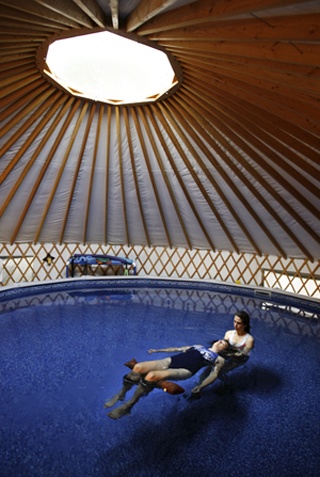The typical workaday world is noisy. Julie Rosenblatt’s is not.
“Our life has become over-stimulated,” she said. “Here, you have an hour where you’re in a bubble. The body is able to really slow itself down.”
In late September, Rosenblatt opened Healing Waters, a warm-water therapy practice that takes her professional experience – five years as a massage therapist followed by 19 years as a chiropractor – into a completely new realm.
“I’ve just now retired from what I call my ‘land work’ into the water,” she said.
Healing Waters is based just upstairs from Rosenblatt’s former chiropractic practice on Knechtel Way. A cozy space painted aqua serves as her office and meeting room, but the real work takes place in a cedar-framed yurt constructed in the back.
There, in the circular, woodsy-scented room, sits a raised pool filled with warm salt water where clients can be worked out, blissed out, or any combination of the two.
Water therapy, like many kinds of therapeutic body work, takes a number of different forms.
There’s WATSU (water Shiatsu), in which Rosenblatt is certified and which she characterizes as pure relaxation rather than deep tissue or muscle work. There’s also Aquatic Integration, Adaptive Aquatics, Waterdance, and Aquatic Rehabilitation Therapy, to name a few.
The modalities may have subtle or marked differences and applications, but the same overriding idea applies: being buoyed by water removes the overstimulation and pressure that our bodies endure on dry land, thereby calming our systems and enabling a practitioner to manipulate our limbs and muscles freely to therapeutic effect.
“The work in the water is very varied. It can go from completely blissful relaxation to really deep musculoskeletal work,” Rosenblatt said.
Her own brand draws from many of the available techniques, and she tailors her sessions to each client’s needs. She works with both genders and all ages; her youngest client is 4, her oldest is 90.
Name the thing that needs attention, whether it’s related to general well-being or to a specific ailment or challenge, and the practitioner says water therapy can help.
She cites conditions like Parkinson’s disease, multiple sclerosis, chronic fatigue syndrome and fibromyalgia, as well as behavioral issues and neurological conditions like Attention Deficit Disorder and autism spectrum disorders.
“It touches everything,” she said.
A session with Rosenblatt begins with a half-hour discussion followed by an hour in the water.
In the pool, heated to around 97 degrees, she gently reclines her client, sometimes using cushions or floats to help buoy the body. Then, she begins to move. She spins and walks the client around the pool, loosens tense limbs, massages out knots, identifies and eases pressure points.
Rosenblatt’s brand of water therapy isn’t like a traditional physical therapy session, during which the client actively moves and works areas of the body. Instead, the recipient remains passive and relaxed, as during a massage.
With ears submerged most of the time, the client can hear only the water. It’s impossible to keep the eyes open, although doing so reveals only the tall trees through the skylight. Many clients report that during a session they forget that Rosenblatt is even there.
It’s an environment in which the recipient is given permission to let down his or her guard, stop paying attention, and surrender to the water and the movement.
“It’s a dance,” Rosenblatt said.
A session in the water can also lead to self-discovery. Rosenblatt said some of her clients reap the complementary benefits of going straight from a session in the pool to a session with their regular talk therapists.
Recently, she worked with a 9-year-old boy with “a lot of extra fire” and behavioral challenges. After a few sessions in the pool, his parents reported a calmer demeanor, an improved attitude, and better sleep.
One evening, the boy’s mom placed broccoli on his dinner plate. Whereas once he would have thrown a temper tantrum about being presented with any loathed food, this time he regarded it, accepted it…and ate it.
A child of that age doesn’t necessarily have the language to describe his experience of the world or possess the wherewithal to construct his own roadmap to self-care.
What he most likely understands, and what his parents observed, is that being in the water has helped him approach life with less tension and anxiety. He simply feels better.
“We carry so much cellularly that we don’t have the words for it – and then you come into the water, which is a very evocative environment,” she said.
For her own part, Rosenblatt notes that water work isn’t as physically taxing as her traditional chiropractic practice was. But it does carry a weight of its own.
“This is really, I could say, the most powerful work I’ve ever given, or received,” she said.


